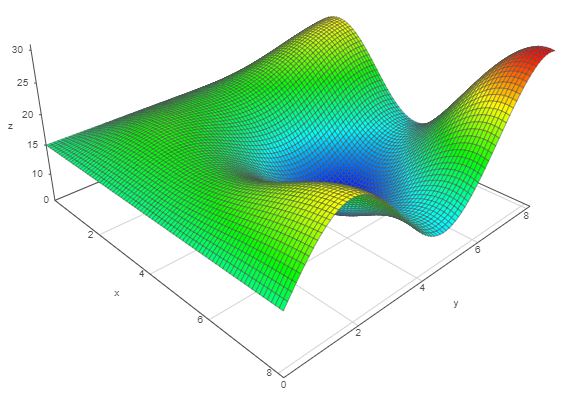TL;DR
Genetic algorithms (metaheuristics algorithms family) help us solve problems which are impossible, very hard or take too long to solve by other solutions.
Genetic algorithms are algorithms that uses evolution inspired approaches to
solve problems that are too hard to solve using other methods. Genetic
algorithms are called meta-heuristic because they don't solve problems in
traditional way. They are a part of big metaheuristic algorithms family (e.g.,
ant algorithm, swarm algorithm). They are used to search for solution by
trying to guess the best solution. Guessing means that we don't know the
actual algorithm that will give us a final solution, we can't be sure that we
will find a solution at all. Let's image a following function:
We can see that the space range, here is defined as:
\[ x \in \{ 0 \dots 8 \}, y \in \{ 0 \dots 8 \} \]
As we can see there is one global maximum in this space at \( (x,y) = (8, 8) \).
We can also see that we have two close "local maximums" \( (x,y) = (8, 2) \) and \( (x,y) = (2, 8) \).
This function shows that randomly
guessing the solution around the space may give us not the right maximum
but we can "jump" into one of local maximums. That's the problem with
meta-heuristics, we never know if we will find a solution. The big pros
for that kind of methods is possibility of find a solution in the spaces
where other algorithms fails, are to hard to implement or finding
solution takes too much time.
Multiobjective optimization
Let's image a following problem. We have to plan chemotherapy treatment in a
way that we need to minimize the amount of toxic drugs that cause unwanted
side effects in human body. From the other way we want to kill the cancer
cells therefore we can't limit the efficiency of treatment too much. No
classic algorithm will help here. We have a huge space of possibilities
because planning of chemotherapy requires from us to consider many important
aspects of human body. We can't make to big injections of toxic substance to
not kill the patient, we have to bare in mind his suffer/pain and take under
considerations all the side effects. Let's remember that chemotherapeutic
drugs are poisons.
Because of such many limitations of such treatment we will have a lot of
constraints for our solution and all of them are important. Searching a
solution for many different objectives is called multiobjective optimization.
This is one of the most important field where genetic algorithms can help.
Having a set of objectives make it impossible to find one solution. In
multiobjective optimization we search of number of optimal solutions creating
a front of good solutions. We call it Pareto-optimal front.
Andre A.Keller,
Multi-Objective optimization in theory and practice II:
Metaheuristic algorithms (book cover)
Metaheuristic algorithms (book cover)
Above picture shows an example of Pareto front in three-dimensional space of
solutions for 3 objective functions \( (f_1, f_2, f_3) \). The optimal
solutions create a something looking like a fragment of sphere.
That could be an example of many different solutions of treatment, each dot
can denote one plan of chemotherapy treatment.
Why good, why not?
Some people says that metaheuristics is like a crystal ball, you never know
what you see and what you get. Others will say, thanks to the mutation and
crossover operators in genetic algorithms we can even accidentally, but still,
jump into the best solution. Opinions are divided. First opinion is some way
true. Because of that unpredictability I prefer to use non-heuristic
algorithms for well known problems. Imagine to use genetic algorithms for
sorting, not really :-) Same with e.g. backpack problem, nooo.
But when you see a very hard problem, with a number of objectives, constraints
and models you doubt, that you can find a classical algorithm to solve it. In
such cases I prefer metaheuristics. I personally really like the origin of
genetic algorithms, the ideas drawn from genetics and evolution. This
inspiration from nature may be sometimes closer to the real world. Of course
we always model things, problems are explained in functions then functions are
calculated. Anyway, using special operators known from genetics and well known
in nature may be really fascinating. Discovering new ways to mutate genes in
our virtual population, or crossing over chromosomes is really interesting
thing, believe me!
That's all for the intro. I encourage you to read other posts in the
series Genetic Algorithms.



Comments
Post a Comment